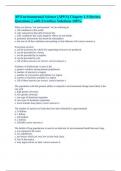Exam (elaborations)
AP Environmental Science (APES) Chapter 1-9 Review Questions || with Errorless Solutions 100%.
- Course
- Institution
When we discuss "our environment" we are referring to a. All conditions in the world. b. only interactions that affect human life. c. only conditions that cause negative effects on our health. d. primarily interactions that harm the atmosphere. e. the sum of all the conditions surrounding us t...
[Show more]



